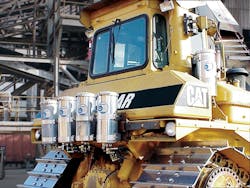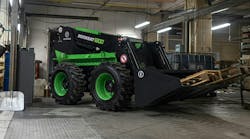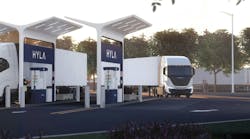“Real estate in construction machines has always been tight,” says Steve Zumbusch, director of advanced systems engineering for Eaton, “so there’s always been a premium on making hydraulic packages smaller. Tier 4 is changing the equation a bit with its emphasis on machine efficiency, and equipment manufacturers see increased value in smaller, more powerful hydraulic packages.”
According to Terry Hershberger, Bosch Rexroth’s director of sales/product management for mobile hydraulics, issues with Tier-4 packaging and hydraulic components have more to do with the dynamics of the Tier-4 engine than with the overall size of components.
“The basic consideration is to optimize and size hydraulic components to allow the most effective and efficient transfer of available power from the engine, in whatever condition the engine operates to meet Tier-4 requirements,” says Hershberger. “Tier-4 packaging often demands more space, while hydraulic suppliers are asked to fit greater power-transfer capability into packages equivalent in size to those used with pre-Tier-4 engines. Maintaining machine function, given changes in engine technology, is a focused area of hydraulic-component development.”
Says Jeff Maney, director of engineering/EMS, Concentric Rockford: “Power density is always an advantage—higher power output with less space claim. The engine footprint continues to grow, leaving less space for drive equipment, including fan drives.”
Judging from these comments, the Tier-4 environment is serving to intensify the scramble for space to house a machine’s mechanicals and to intensify the demand for operating efficiencies in the name of fuel efficiency.
For mobile hydraulic systems, these factors can translate into more power-dense pumps and motors (drawing more capability from a given size), more-compact valve packages, smaller hydraulic reservoirs, perhaps smaller cylinders, regenerative designs that reuse oil without it passing through the pump, and hybrid systems that capture and store energy hydraulically.
The path to saving space and increasing efficiency, in some instances, can mean higher system pressures, says Zumbusch. Theoretically, he says, doubling pressure allows the displacement of hydraulic pumps and motors to be halved, resulting in smaller components that are more robust to sustain increased loads and that typically have much tighter machining tolerances to maintain efficiency.
Hydraulic filtration and fluid
Higher pressures and tighter tolerances have maintenance implications: “One of our concerns from a maintenance standpoint is that of filtration—the overall cleanliness of the system,” says Zumbusch. “With the tighter tolerances involved, any particle of dirt larger than the clearances we design in will erode away material to fit its size.”
A related concern is that of proper hydraulic-fluid selection. As hydraulic systems work at higher pressures in hotter Tier-4 environments (diesel particulate filters can regenerate at temperatures exceeding 1,300 F), the fluid’s ability to maintain viscosity becomes critical for keeping an adequate oil film between close-tolerance parts.
OEMs increasingly are specifying fluids with higher-quality base stocks that complement carefully formulated additive packages, yielding fluids that meet requirements of specific hydraulic systems. In addition, recommended fluids increasingly use high-quality viscosity-index (VI) improvers, engineered molecules that help fluid maintain more consistent viscosity throughout the hydraulic system’s range of operating temperatures.
VI improvers in today’s high-quality hydraulic fluids also are increasingly shear-stable, more resistant to breaking apart in use, which can occur, says Shell Lubricant’s Stede Granger, OEM technical services manager, when fluid passes through a small orifice or through high-pressure pumps and motors. Shear-stable fluids are good at maintaining their engineered viscosity properties, says Granger.
Hydraulic-fluid manufacturers offer a selection of products to meet a wide range of machines and operating situations, and Tier-4 equipment owners must make studied choices, guided by OEM recommendations.
“Avoid the lure of inexpensive hydraulic fluid,” says Jeremy Wright, vice president of technical services for Noria Corp., a company specializing in lubrication program development, machinery lubrication, and oil-analysis training. “Typically, these fluids don’t have the right additive package, don’t have a good-quality base oil, and have poor oxidation resistance. The other extreme is thinking that the most expensive oil will fix all your problems; not true. Usually somewhere between is the OEM’s engineered approach.”
Other hydraulic considerations
“The mobile-hydraulic industry is notorious for turning reservoir volume over more frequently than other equipment industries,” says Concentric’s Maney, “and heat rejection can become critical.”
Shell Lubrication’s Granger is of the same opinion: “If the reservoir gets smaller to save space, then there’s more stress on the oil. Each molecule goes through the cycle more frequently and can be exposed to higher temperatures.”
Says Eaton’s Zumbusch: “Hydraulic-component people suggest a reservoir size, but OEMs might chop that down in the interest of space. This pushes the fluid’s limits, because dwell time in the reservoir is important, primarily to allow fluid to de-aerate [release entrained air] and to allow contaminates to fall out.
“We’ve always been pressed hard on this [reservoir size] issue—harder, now, with Tier 4,” says Zumbusch, “and we’re working on solutions. Eaton, for example, has developed the Cyclone Tank, which creates a cyclonic action in the reservoir that pushes air to the center to be ‘burped out’ and dirt to the outside so it can be chased to the bottom. Dwell time can be considerably reduced—by a factor of seven in some systems.”
Potential heat-related damage to hydraulic fluid resulting from smaller reservoirs and more frequent cycling, coupled with the already generally hotter Tier-4 environment, makes maintenance of coolers critical, both hydraulic and engine. Zumbusch reminds machine owners, too, that airflow characteristics of today’s machines are precisely designed, and any modification that jeopardizes the way air passes over components and through heat exchangers could result in elevated temperatures.
The Tier-4 environment also makes hose maintenance all the more important. Tighter confines in Tier-4 machines make hose routing a challenge, and in some instances, says Concentric’s Maney, “space claims can negate preferred bend radii or even require smaller sizes.” As pressures increase, says Eaton’s Zumbusch, some manufacturers add reinforcement to hoses, making compact-radii bends difficult. Eaton, he says, designs hoses for specific applications in some instances, recognizing, for example, that the duty cycle of a propel system is far different from that of a boom cylinder.
The point here is to be cautious about hose replacement, keeping in mind that a hose might be specifically engineered to work in a particular location; substituting a hose that does not meet all required specifications could potentially alter bend radii or fail to meet pressure requirements, to the detriment of system’s efficiency and safety.
Back to filtration
“Were I a machine owner, I’d focus my time, energy, and resources on the cleanliness of hydraulic fluid,” says Noria’s Wright, “because dirty oil is the primary failure mode for most machines, and component life extension with cleaner fluid is enormous. Many fleet managers don’t realize that hydraulic-system problems might really begin when fluid is delivered.”
Wright cites a study conducted at Monash University for a Texas utility company to determine the cleanliness of hydraulic fluid delivered in drums and in bulk from six major suppliers. Some samples were perfectly fit for use, he says, but on average, most were exponentially dirtier than prescribed standards, with bulk deliveries generally more contaminated.
As measured by ISO (International Standards Organization) code 4406:1999, delivered-fluid ratings averaged 21/18/15, says Wright. Target cleanliness for a mid-size excavator, he says, should be on the order of 16/14/11, which, as you can determine from the ISO rating chart, represents an exponentially cleaner fluid. Fleet owners, he says, should be concerned with the fluid’s entire lifecycle—cleaning it upon delivery, keeping it clean in storage, transferring it cleanly to machines, and keeping it clean in the machine.
For bulk-storage systems, filter manufacturers and oil jobbers often can assist fleet owners with designing filtration systems that clean hydraulic fluid passing into and out of storage. Also available are desiccant breathers that remove moisture and contaminates from air entering the tank, as well as proprietary drying systems, which might blanket the fluid with dry air to remove water.
Noria’s Wright would take the protection of fluid in bulk storage a step further by installing a circulating filtration system, with the dual purpose of maintaining fluid cleanliness in the tank and preventing additives in the fluid from stratifying, because additives heavier than the base oil, he says, can settle out.
Drum storage has its own concerns, says Wright: “You can actually use up oil before dispensing it into a machine if it’s stored in dark-colored drums outside, where it absorbs the sun’s heat. Shoot the drum with an infrared thermometer, and it could be 180 F or more—cooking the oil in the drum as it sits on the pallet. Also, temperature fluctuations cause drums to breathe, possibly drawing in dirt and moisture. If possible, store drums indoors, preferably in a climate-controlled area.”
By-pass filtration and particle counting
Hydraulic systems using sensitive, close-tolerance components and controls require high-efficiency filtration, says Pierre Niewland, president of NTZ Micro Filtration. But as Tier-4 engine packages claim more space and thus restrict space for overall hydraulic-system packaging, he says, it follows that “under-hood” space for filtration is being decreased as well. Niewland suggests that by-pass filtration can be a means to high-efficiency fluid cleaning required by today’s sophisticated hydraulic systems.
By-pass filtration systems supplement the OEM’s “full-flow” filtration system by continually diverting a small volume of hydraulic fluid (0.5 to 2.0 gallons per minute) and passing it at reduced pressures (15 to 50 psi) though an exceptionally fine filter, which also absorbs water. Some by-pass filters are marketed as having as low as 0.5-micron retention values. (A micron is one-millionth of a meter; particles become visible at about 40 microns.)
“Most damage to hydraulic systems is done by particulates smaller than 7 microns and by water,” says Keith Nye, owner of Perfect Filtration Systems. “Water jeopardizes the viscosity of the fluid and can break down the additive package. Our by-pass systems use 3-micron-rated, depth-type filters that can remove solid contaminates below 1 micron in size, as well as remove free and emulsified water.”
Because a machine’s OEM filters must accommodate the hydraulic system’s full flow through practically sized packages that must not cause excessive restriction, say by-pass filter advocates, these filters might not be as capable as by-pass filters for removing the smallest particles, nor do they typically absorb water. According to Nye, a by-pass filtration kit from his firm typically costs around $1,100 and requires two to three hours for installation.
Along with by-pass filtration, Noria’s Wright also is a proponent of particle counting as a technique for maintaining hydraulic fluid: “If you’re a fleet manager and want the biggest bang for your preventive-maintenance buck,” he says, “invest in a particle counter. Laser-type instruments have come down in price, they’re easy to use, and provide repeatable results.
“With a particle counter, you can track fluid through its lifecycle to find any breakdowns in the system—storage, dispensing, or in the machine,” says Wright. “Set a cleanliness goal for your machines, and if you keep particle contamination in check, you can greatly extend component life and reduce downtime.”
NTZ’s Niewland also is a believer in particle counters, suggesting that hydraulic fluid in use be checked frequently to monitor its condition, in addition to regular laboratory fluid analysis. He says that he still encounters equipment owners who are of the opinion that large construction machines can swallow marbles with impunity, but the truth is, he says, particles as small as 4 microns can kill a machine’s hydraulic system.
In the Tier-4 environment, sounds like good advice to be on the lookout for these tiny troublemakers.





